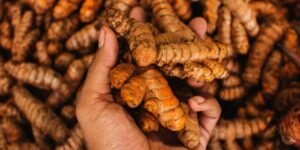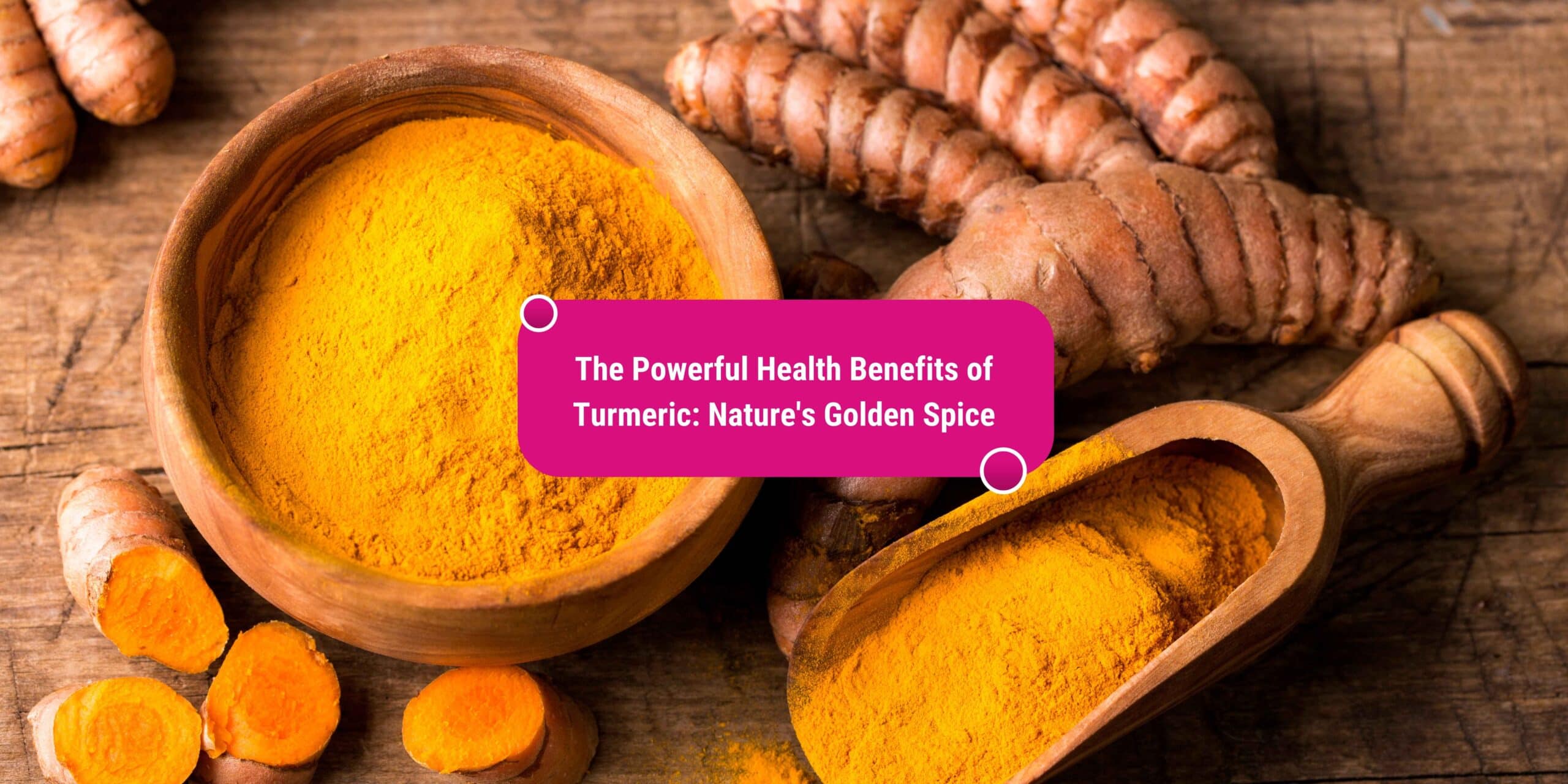Just about everyone loves the bright yellow color and slightly spicy flavor of turmeric, the powdered root spice commonly used to make curry. But recently, turmeric has been gaining attention for more than just its taste appeal. It’s being recognized for its potential health benefits that have been studied in humans, and even more in-depth in test tubes and animals. In recent times, guidance from health organizations and food companies has advised consumers about routinely including spices like turmeric in their foods, specifically fighting against chronic diseases like diabetes, cancer, and gastrointestinal disorders. Here, we will talk through the most up-to-date information about turmeric’s health perks and explore what possible doors could be opened in the future.
The main purpose of this essay is to provide new evidence-based knowledge about what properties turmeric could potentially offer as part of a strategy to build oneself up from the inside out. We are not implying that turmeric or any substance on its own is a cure-all or cause of no harm. Curcumin, the active compound in turmeric, has long been consumed, especially in higher amounts than we would typically consume turmeric as a spice in the U.S., in traditional medicine systems in Southeast Asia. Western science has been paying attention to these other sides of the world treatments, initially reported in modern studies in the late 1900s, with more intense scientific exploration starting around the turn of the millennium, with more than 4,000 research publications now coming to fruition. The interest in curcumin has led to scientists developing new forms of delivery to humans, from better-absorbed supplement pills to injectable curcumin for effective pain relief that is being tested in cancer patients. With these continued investments in turmeric, it is clear that we are shifting our focus to learn how we can affect the human body with valid, evidence-based opportunities using nature’s golden spice. That’s what this essay series is all about.
Historical and Cultural Significance of Turmeric
Turmeric is a flowering plant from the ginger family. The rhizomes are used in cooking and in herbal medicine as a popular dietary supplement. Approximately 7,000 scientific studies have been conducted to explore turmeric’s benefits and applications, which are many. Turmeric probably will be the most researched substance on earth. This is how popular it has become in the quest for non-drug solutions to chronic disorders and degenerative symptoms. Turmeric is one of the few substances on the planet so diverse both in terms of history and medicinal use.
Turmeric is indigenous to South Asia, specifically the thin forests of Karnataka or Southern India. It became a part of the ancient tradition of the Indian subcontinent. It is used in hearty and flavorful dishes native to Southern India, stretching through the regions of Asia and the South Pacific to Polynesia. These areas of concentration have fixed in the cultures the traditions of using turmeric. Just south of India, Neolithic terracotta pottery shards have been found dating back 3,000 years; residues showed evidence of cooked food including ginger and turmeric, garlic, and sesame seeds. Traders from Greece would later carry turmeric to China, which was thriving with the life of spiritual healing, the forerunner of the setting of the pulse and acupuncture systems. Turmeric appears in a list of the materia medica of the Tang dynasty of China in the 7th century, used to treat pain and inflammation and as an aid to healing digestive disorders. Herbalists of Persia and the Middle East also used turmeric. In the 13th century, it was noted that turmeric had a vigorous yellow color and that the people also used it to dye their embroidered shirts. In the Middle East, the dye was more expensive than the golden root itself.
Chemical Composition and Nutritional Profile of Turmeric

One of the primary active components in turmeric is curcumin, the pigment responsible for turmeric’s iconic color. It has long been considered the primary active ingredient responsible for many of turmeric’s potential health benefits. However, the complex compounds possessed by turmeric operate synergistically to promote health through a number of mechanisms. Unfortunately, the absorption of curcumin is notoriously poor. As a result, even a large dose of curcumin produces only minute quantities of the active compound in the bloodstream. There are a number of approaches scientists have taken to attempt to improve curcumin bioavailability.
In general, the nutritional profile of turmeric is characterized by high antioxidant capacity and low-calorie energy density, which can contribute to the overall metabolic function of the body. The primary macronutrient constituent of turmeric is carbohydrates. In many cases, the majority of carbohydrates in turmeric come from dietary fiber. Furthermore, turmeric is low in sugar, fat, and protein. An average serving size of turmeric contains about 31.4 g of carbohydrates, 20.8 g of dietary fiber, and 8.35 g of sugar. Turmeric is also rich in essential nutrients such as vitamins and minerals. Turmeric is a good source of vitamin C, vitamin E, and vitamin K. For the mineral profile, turmeric contains high levels of iron, potassium, zinc, and magnesium.
Evidence-Based Health Benefits of Turmeric
1). Topic: The Powerful Health Benefits of Turmeric: Nature’s Golden Spice
2). Section Title: Evidence-Based Health Benefits of Turmeric
3). Section Summary:
Turmeric is a beloved spice with a lot more to offer besides its rich, earthy flavor. Its value is now being unraveled from a long history of traditional medicine to an increase in scientific research. The verified and promising health benefits of turmeric range from easing arthritis and joint pain, potentially reducing cholesterol levels, lowering heart disease risk, managing blood sugar levels, and much more. Because of this impressive evidence, more and more people are considering turmeric supplements to get more from their everyday diet or help reduce their dependence on traditional medications. The numerous turmeric benefits help get at the root of the cause and deliver support in a natural way by supporting drug-free healing solutions. The three closely related but intriguing aspects of the many health benefits of turmeric include emphasis on supporting a healthy microbial balance, beneficially influencing a healthy inflammatory response, and reducing oxidative stress.
Turmeric, the main spice in curry, is arguably the most powerful herb on the planet. It has been used in India for thousands of years as a spice and medicinal herb. Recent research reveals some of the remarkable health benefits of using turmeric in your diet. Turmeric is packed full of antioxidants and anti-inflammatories that scientists believe are behind its therapeutic potential, though further research is ongoing. For example, curcumin appears to help prevent heart disease, improve symptoms in patients with ulcerative colitis, and reduce symptoms in people with anxiety. Some studies suggest that substances in turmeric may help reduce insulin resistance, improve hemoglobin A1c, and improve tolerance of the sugar test in type 2 diabetes.
Anti-Inflammatory Properties
The powerful health benefits of turmeric are impressive. Its ability to reduce inflammation is one of the most notable of its many attributes. The anti-inflammatory effect of turmeric can be attributed to one of its constituents known as curcumin. Curcumin is known to interfere with many inflammation pathways in the body by affecting a number of important molecules acting within these pathways. This makes turmeric a great natural option in the management of both acute and chronic inflammatory diseases. The use of turmeric may be particularly helpful for those who are already consuming a strong pharmaceutical option for their inflammatory disorder, as sometimes combined treatment with natural and pharmaceutical medications can have a synergistic and beneficial result. This anti-inflammatory effect that turmeric has can assist in treating or reducing the symptoms of chronic inflammatory conditions such as osteoarthritis, rheumatoid arthritis, inflammatory bowel disease, precancerous conditions such as polyps of the large bowel, depression, angina chest pain, hardening of the arteries, and kidney function for patients who have chronic kidney disease or kidney failure. The evidence in relation to these conditions when using turmeric is particularly supportive of the effectiveness of turmeric or the full spice over the isolated constituent. A possibly promising effect of turmeric supplements is the reduction in the degree of inflammation in the body experienced after an exercise session. Exercise is known to result in inflammation in the muscles and body, and substances such as curcumin are thought to help reduce the body’s inflammatory response in this situation, assisting in recovery and adaptation to the exercise. The use of turmeric, particularly as a full spice in cooking as well as a supplement for the prevention and management of inflammation, is in the early phases of growing scientific interest in its effectiveness.
Antioxidant Effects
Turmeric functions as a neutralizer against the damaging effects of oxidative stress and aging by counteracting the actions of harmful free radicals. This golden spice contains the antioxidant compound curcumin, along with curcuminoids and a variety of other phytonutrients and compounds. These substances work in the body to find and negate free radicals, preventing cellular damage, fighting off disease, and promoting overall longevity. Clinical research has explored the potential effects of turmeric and its compounds on disease risk, and studies have shown that standard turmeric extracts can reduce the incidence of heart disease and the risk of obesity-related diabetes. More studies are needed, but the research that has been conducted so far suggests that incorporating turmeric into one’s lifestyle might be able to help prevent chronic diseases such as heart disease and type 2 diabetes.
One common sign of aging is the increase in oxidative stress that the body must deal with as it gets older. By consuming turmeric and other antioxidant foods, it may be possible to reduce the advance of diseases and aging by neutralizing the effects of excess free radical production. Dietary sources of antioxidants include green tea, berries, dark-colored vegetables such as kale and spinach, beets, carrots, dark chocolate, nuts like walnuts and pecans, extra virgin olive oil, and a variety of spices such as turmeric and ginger. Adding these foods to the diet and lifestyle can help to promote a healthy balance of antioxidants in the body. When the balance is thrown off, a person might have an increased risk of experiencing oxidative stress, a condition that may lead to serious chronic diseases.
Supplementation with turmeric and its compounds is a practical way to boost overall antioxidant intake from day to day. For example, you can add this versatile spice to meals or consume turmeric in the form of a dietary supplement.
Potential Anti-Cancer Properties
There is a rapidly growing interest in the potential anti-cancer properties of both turmeric and its primary pharmacological compound, curcumin, and this is an area of active research. Since the early 1990s, an increasing number of studies began examining curcumin in a laboratory setting to determine whether it had the ability to stop the growth of cancer cells or make them kill themselves. These findings ultimately resulted in multiple patent applications. An increasing number of experiments on cell and animal models have found that curcumin has both anti-cancer and cancer-promoting properties. A review of multiple studies from various laboratories around the country that tested curcumin in the laboratory suggests that it can stop cancer cells from growing, dividing, or producing signals used in tumor growth and survival.
Populations that consume more dietary turmeric in general have lower rates of certain cancers in the U.S. and elsewhere, and some laboratory and animal model studies show that curcumin can benefit a wide range of additional cancers, including those of the colon, breast, pancreas, bladder, liver, and more. Although it has been observed to have multiple anti-cancer activities, research on the potential direct effects of dietary turmeric on cancer prevention and on cancer patient outcomes is largely either inconclusive or yet to be studied. Some laboratory research suggests that curcumin may help prevent cancer, including through effects on DNA, blocking of harmful inflammation, and stopping the growth, migration, and invasion of cancer cells. Population studies in India suggest that consumption of dietary turmeric is associated with lower rates of certain cancers in that population, including gastrointestinal cancer. However, other factors related to India, such as a generally lower body mass, could also contribute to these differences. Some pilot clinical trials in cancer patients have found that curcumin may help treat cancer patients in various ways. However, these are very small studies and have not been repeated in larger groups of patients, so it remains largely unknown whether dietary turmeric or curcumin supplementation actually has an impact on cancer outcomes. More comprehensive and controlled studies are needed to definitively determine the value of turmeric for patients with cancer in combination with other methods.
Digestive Health Support
Aside from being a pantry staple, turmeric is also a well-known digestive system soother. Importantly, curcumin is believed to increase bile production and, as a cholagogue, promote the gallbladder’s healthy emptying. Bile helps to emulsify dietary fats; as such, a healthy surge of bile promotes superior fat digestion and nutrient absorption. Bile, with its rich pigment, also contributes to the feces’ golden yellow appearance—a further representation of curcumin’s bitters.
Understandably, many individuals harness turmeric as an analogous natural treatment for irritable bowel syndrome, a condition marked by spasms, bloating, constipation, and/or diarrhea. The use of the household seasoning to alleviate indigestion and digestive complaints associated with reduced gallbladder function are approaches also backed by clinical research. Furthermore, studies support the use of herbal preparations rich in curcumin to assist in addressing dyspepsia and to reduce symptoms of dyspepsia. This golden beauty has other benefits, too; remember, its gut-balancing, anti-inflammatory, and antioxidant actions all contribute to overall health.
Adding ground turmeric to your bone broth or smoothie, mixing it into curries, stews, and soups, or adding it to your morning pancakes are all effective ways to consume it in the diet. For non-culinary days, consider incorporating a high-potency turmeric supplement into your daily routine as an alternative. When experiencing a gallbladder issue, it is recommended to consult a healthcare practitioner: curcumin stimulates bile secretion and could exacerbate symptoms if the gallbladder is dysfunctional.
Joint and Bone Health
With age, maintaining joint health becomes increasingly important to support our bodies. Turmeric offers impressive support for nearly all concerns related to the musculoskeletal system, from inflammation to bone density loss. The anti-inflammatory properties can enhance mobility by alleviating issues of inflammation associated with painful conditions involving our muscles, tendons, bones, and joints. In addition to preventing injury and remaining active, healthy, movable joints are high energy. Turmeric has mounting evidence to prove it can make good on that claim. Many studies have been conducted focusing on particularly small cohorts post-injury, with a number of case studies focusing on their experiences, as well as larger cohorts and clinical trials focusing on other inflammatory and degenerative joint conditions such as osteoarthritis and rheumatoid arthritis. Our first study, a case series, demonstrated the efficacy of our proprietary Curcumin Complex in eight individuals suffering from significant musculoskeletal injury post-ACL repair and lower extremity hardware removal. Our curcumin supplement demonstrated significant benefits over supplementation with ibuprofen, helping to accelerate recovery and control inflammation, pain, and post-injury muscle damage.
People with other musculoskeletal concerns such as joint degeneration were quicker to show results. The body of data based on this study shows that a full 50% of the group taking our curcumin supplement showed substantial functional improvements within a week or less, while only 6.7% of those taking a placebo did. This is likely due to curcumin operating along the same anti-inflammatory pathway as the study group individuals who showed results by day 7. An estimated 15 million adults were diagnosed with osteoarthritis at some point during 1998–2005. It is characterized by the deterioration of articular cartilage in synovial joints, such as hips, knees, and lumbar spine, due to injury and/or biomechanical stress. Cells called chondrocytes produce the extracellular matrix in the cartilage, and when their catabolic and anabolic balance is disrupted by excessive pressure and/or decreased blood supply, the repair of damaged cartilage decreases, reducing the function and mobility of the affected joint. Ultimately, many affected individuals undergo joint replacement. A second study demonstrated accelerated tissue repair in a 29-year-old woman with a rare autoimmune disorder causing skin blistering, scarring, and contractures on her legs. Our Curcumin Complex continually improved her condition over an eight-month regimen until it was gone completely.
Cardiovascular Benefits
Many studies have shown that regular consumption of turmeric can promote heart health. Some studies demonstrate that the spice can reduce “bad” LDL cholesterol levels in the blood. The active compound, curcumin, is thought to alter the way that the liver removes cholesterol from the body, preventing the body from absorbing as much as it normally would. A review of studies has confirmed that curcumin does indeed reduce the amount of cholesterol in the blood. Besides its potent cholesterol-reducing abilities, turmeric and curcumin possess various other properties that are believed to protect heart health. Many trials have shown that they can improve endothelial function and overall circulation, as well as reduce oxidative stress, systemic inflammation, and other risk factors for heart disease. Not only do these benefits act to protect the heart, but they may also help to lower blood pressure.
One study found that consuming a daily dose of turmeric was able to reduce symptoms associated with heart disease. From these cardiovascular benefits, it is not surprising that regular users of turmeric present with lower overall risk factors for heart disease. Turmeric intake has been linked with improvements in cholesterol levels, oxidative stress, systemic inflammation, high blood pressure, blood lipid levels, and blood sugar control. Furthermore, the antioxidant and anti-inflammatory effects of turmeric, mediated through curcumin, are likely to protect the endothelial lining of the circulatory system. The endothelium is responsible for regulating vascular flow and preventing the formation of blood clots; its healthy functioning is tightly associated with longevity. Because the food we eat holds the power to either support or impair the health of our heart, it is important to be proactive in this area. Adding golden turmeric to soups, teas, lattes, scrambled eggs, rice dishes, marinades, and more is an easy way to boost our cardiovascular defense systems.
Methods of Incorporating Turmeric into Your Diet
Turmeric in its various forms – fresh, powdered, as an ingredient in supplement capsules – can be employed in a boundless number of dishes or activities. Here are a few suggestions on how to make turmeric an effective component of your daily health regimen. Simple Culinary Uses: Add turmeric to soups and stews, especially hearty ones that include lentils, chickpeas, or other healthy legumes. A small pinch goes a long way. Dust a bit of powdered turmeric on roasted veggies, like cauliflower or carrots with cumin and turmeric! Bonus points if you also use a bit of black pepper: the piperine in black pepper has been shown to increase the bioavailability of the curcumin in turmeric. Sprinkle over savory breakfast dishes, such as eggs, breakfast hash, or oatmeal with sautéed greens. If it is a savory side of breakfast, it also gets the turmeric treatment. Make a turmeric latte – combined with ingredients such as ginger and cinnamon, this Ayurvedic drink is a soothing way to wind down at the end of the day. Get Creative! Whip up a turmeric smoothie – tropical fruits like pineapple are an excellent mask for the peppery, earthy flavor of turmeric. This is especially great if you’re not cooking with turmeric in any savory dishes during the week. Bake a turmeric cake or snack bars. The warmth and sweetness of turmeric is well-suited to a wide variety of desserts. Brew some turmeric tea – combined with lemon juice and a bit of sweetener, this kind of tea can be enjoyed hot or cold. If choosing a turmeric capsule or supplement, look for smooth paste or softgel capsules containing bioperine or black pepper extract. Generally, it is recommended to start with up to 1 gram of ground turmeric daily. Of course, as with any dietary supplement, we recommend consulting your healthcare provider. Some have found that the earthy flavor of turmeric can be strong and may require some getting used to for many people. If your stomach is sensitive to certain flavors, despite these minor complaints, it is clear that turmeric is an incredibly versatile and nutritious ingredient that provides numerous potential health benefits. Give turmeric a try by incorporating it into your diet today to experience the healing and preventative power of this golden spice.
Potential Side Effects and Precautions
In spite of its many uses, readers may wish to be advised on the potential risks of using turmeric. Although it is safe when used in moderate amounts, excessive consumption can cause gastrointestinal discomfort. Readers should also be made aware that taking too much of this spice can lead to a variety of side effects. Some people are sensitive to curcumin and may have an allergic reaction. Pregnant women may want to avoid turmeric as this spice can affect the developing child. Such side effects apart, the compounds found in turmeric and the ability of curcumin to act as an antioxidant make turmeric a very valuable natural supplement to add to people’s regular diet in reasonable quantities. If you decide to go ahead and use turmeric supplements, it is recommended that you take a well-established concentrated powder preparation manufactured by a respected company. Before taking these supplements, discuss turmeric with your primary care provider; they will be able to recommend the best preparation based on your medical history. Make sure you follow the preparation’s guidelines for consumption explicitly. Also, be aware that there may be an unfavorable interaction between turmeric and certain medications. Individuals taking anticoagulants, antiplatelet medications, and antidiabetic drugs should be closely monitored by their healthcare provider to find the suitable doses.
In conclusion, the long history and the many widespread cultural uses of turmeric are fascinating, but the health benefits appear to be its most valuable asset to modern individuals. An increasing body of research addresses hope that studies in the future will validate many of the traditional uses of turmeric. When it comes to personal health outcomes, one epidemiologist emphasized that curcumin, which accounts for the yellow appearance of the powdered spice, is at the heart of the many purported health benefits of the plant. Overall, the health advantages associated with turmeric are multifaceted and have been studied across a wide range of disorders, from necessities as basic as diminishing risks associated with unhealthy levels of blood cholesterol or glucose to potentially cancer-fighting attributes. For years, individuals in modern society have linked many of the functions of turmeric to culinary-inspired purposes, but the colorful history of its origins inspires a belief in its additional health benefits.
It appears evident that turmeric is much more than a flavorful spice to be added on top of a meal with a quick toss. Cumulative evidence provides a viable basis for speculating about botanical curative benefits; however, ongoing investigation to completely understand the therapeutic prospects is essential. Encouraging ongoing research would enable the validation of many of the traditional uses of turmeric, permitting its development into advanced product forms and expansion into unique applications within the global market. It is now well documented that turmeric can successfully improve arthritis signs, reducing inflammation and the stiffness associated with arthritis, while also lessening pain. Turmeric should be considered an essential complementary therapy supplement to support individual lifestyles in order to maximize their health. An increasing number of high-quality human trials are required to achieve further strong support for individuals to contemplate using turmeric in their lifestyles for health and well-being.



